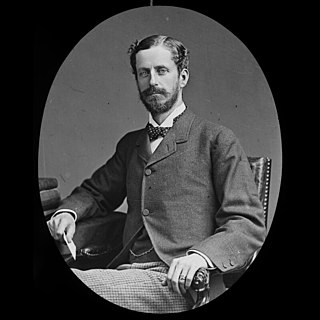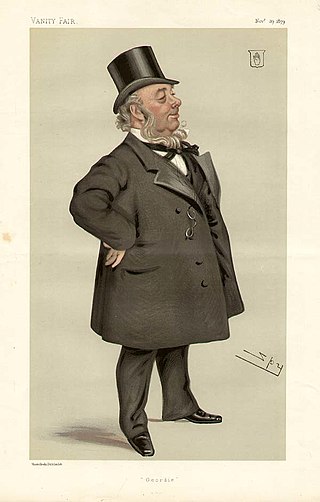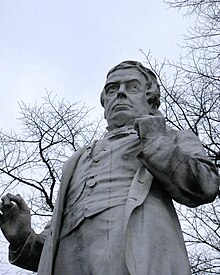"I know nothing comparable in the history of science to that triumphant march —for such it was— when the Liverpool and Manchester Railway was opened."
—George Leeman [8]
In 1849 he became chairman of the York, Newcastle and Berwick Railway, succeeding his rival the 'Railway King' George Hudson after Leeman's investigations helped uncover Hudson's illegal share dealing. [3] [5] Leeman was deputy chairman of the successor company, the North Eastern Railway, from 1855 to 1874 and chairman from 1874 to 1880, having encouraged its formation through mergers in 1854, and he was a chairman of the Railway Association of Great Britain. [3] [9] Leeman resigned as chairman of the NER in 1880 after the failure of his mining company reduced his wealth and harmed his health. He remained a member of the board until his death two years later. [9]
Other business
He was involved the 1860s in developing iron ore mining at Rosedale for Teesside steel works, co-owning the Rosedale and Ferryhill Iron Company from 1860 to 1877. [3] [4] He was a director of the York Herald and chairman of the Yorkshire Banking Company from 1867 to 1880. [4]
Political career

He became a Liberal councillor for Castlegate Ward in 1836 and for Guildhall Ward in 1839, and was an Alderman for 28 years from 1850. [4] He was elected Lord Mayor of York three times in 1853, 1860, 1870, [4] and was the member of parliament for York 1865–8 and 1871–80, [3] having first stood for Parliament in 1852. [10] When Anthony Trollope campaigned in Beverley as a Liberal candidate, Leeman warned him against it; Trollope came last due to corruption and vote-buying. [11]
Personal life
Leeman was born in York, the son of George Leeman, a greengrocer. [2] [4] He lived at The Mount, York, and married twice, first to Jane Johnson in 1835, and second to Eliza, the widow of Rev. Charles Payton, in 1863. [5] One son, William Luther Leeman, attended St. Edmund Hall, Cambridge, and University College, Durham, and was Rector of Middleton St. George, 1874–6, Vicar of Rosedale, Yorkshire, 1877–9, and of Seaforth, Lancashire, 1879–82. [12] His second son, Joseph Johnson Leeman (1842 – 2 November 1883), became a partner in Leeman and Wilkinson and succeeded George as MP for York. [6] [13] [14] [15] Another son, Francis Lawley Leeman (born 19 July 1854, died 1883), attended Westminster School and Trinity College, Cambridge. [16] George also had at least three daughters, including Priscilla. [17]
He was a member of the Reform Club [5] and the Yorkshire Philosophical Society from 1844. [18] He died in Scarborough in 1882. [4] A statue of Leeman by local sculptor George Walker Milburn, paid for by public subscription, was unveiled in 1885 and stands outside York railway station; [3] [19] Station Road was renamed Leeman Road at the same time. [20]
Related Research Articles

Anthony Trollope was an English novelist and civil servant of the Victorian era. Among his best-known works is a series of novels collectively known as the Chronicles of Barsetshire, which revolves around the imaginary county of Barsetshire. He also wrote novels on political, social, and gender issues, and other topical matters.

Lord George Francis Hamilton was a British Conservative Party politician of the late 19th and early 20th centuries who served as First Lord of the Admiralty and Secretary of State for India.

Lawrence Dundas, 1st Marquess of Zetland,, known as Lawrence Dundas until 1873 and as The Earl of Zetland from 1873 to 1892, was a British hereditary peer and Conservative statesman. He was Lord Lieutenant of Ireland between 1889 and 1892.

Arthur Charles Hamilton-Gordon, 1st Baron Stanmore was a Scottish Liberal Party politician and colonial administrator. He had extensive contact with Prime Minister William Ewart Gladstone.

The North Eastern Railway (NER) was an English railway company. It was incorporated in 1854 by the combination of several existing railway companies. Later, it was amalgamated with other railways to form the London and North Eastern Railway at the Grouping in 1923. Its main line survives to the present day as part of the East Coast Main Line between London and Edinburgh.
More than 1,500 African American officeholders served during the Reconstruction era (1865–1877) and in the years after Reconstruction before white supremacy, disenfranchisement, and the Democratic Party fully reasserted control in Southern states. Historian Canter Brown Jr. noted that in some states, such as Florida, the highest number of African Americans were elected or appointed to offices after the end of Reconstruction in 1877. The following is a partial list of notable African American officeholders from the end of the Civil War until before 1900. Dates listed are the year that a term states or the range of years served if multiple terms.

Richard de Aquila Grosvenor, 1st Baron Stalbridge,, styled Lord Richard Grosvenor between 1845 and 1886, was a British politician and businessman. Initially a Liberal, he served under William Ewart Gladstone as Vice-Chamberlain of the Household between 1872 and 1874 and as Parliamentary Secretary to the Treasury between 1880 and 1885. However, he broke with Gladstone over Irish Home Rule in 1886 and joined the Liberal Unionists.

Beilby Lawley, 3rd Baron Wenlock was a British soldier, Liberal politician and colonial administrator who was the Governor of Madras from 1891 to 1896.

Sir George Strickland, 7th Baronet, also known as Sir George Cholmley was an English Member of Parliament and lawyer. He took the name Cholmley to succeed to the Cholmley estates in 1865.

Sir George Elliot, 1st Baronet, JP was a mining engineer and self-made businessman from Gateshead in the North-East of England. A colliery labourer who went on to own several coal mines, he later bought a wire rope manufacturing company which manufactured the first Transatlantic telegraph cable. He was also a Conservative Party Member of Parliament (MP).

Charles Hodgson Fowler was a prolific English ecclesiastical architect who specialised in building and, especially, restoring churches.

Sir George Goodman was an English wool-stapler, a magistrate for the borough and county of Leeds, as well as a Liberal politician. On 1 January 1836, he was elected the first Mayor of Leeds after the Municipal Corporations Act 1835, and he served as a member of parliament (MP) for Leeds from 1852 to 1857.
Joseph Johnson Leeman was an English Liberal Party politician who sat in the House of Commons from 1880 to 1883.

Holgate is a suburb of York in the ceremonial county of North Yorkshire, England. It is located about 1 mile west of Micklegate Bar in the city walls. Holgate is also the name of an electoral ward in the City of York unitary authority. The ward is currently bounded by the River Ouse from Scarborough Bridge to Ouse Acres on its northern boundary. Carr Lane and Ouse Acres on one side, and the intersection of York Road and Acomb Road on the other, make up its western boundary. The remainder of the southern boundary follows Moorgate and Holgate Beck to the East Coast Main Line railway which completes the eastern boundary as far as the River Ouse/Scarborough Bridge.

Sir Saul Samuel, 1st Baronet was an Australian colonial merchant, member of parliament, pastoralist, and prominent Jew. Samuel achieved many breakthroughs for Jews in the colonial community of New South Wales including the first Jew to become a magistrate, the first Jew elected to parliament, the first Jew to become a minister of the Crown.
Sir Charles Whetham was an English businessman and politician who served as Lord Mayor of London in 1878–1879.
SirAlexander Kaye Butterworth (1854–1946) was the General Manager of the North Eastern Railway and also chairman of the Railway Executive during the First World War. He was the father of the composer George Butterworth (1885–1916)

James Raine (1830–1896) was a British antiquarian and ecclesiast. He was a Canon and Chancellor of York Minster.
Joseph Koch was a Jewish-American lawyer, judge, and politician from New York.
References
- ↑ "The House of Commons constituencies beginning with "Y"". Leigh Rayment. Archived from the original on 10 August 2009. Retrieved 3 July 2010.
{{cite web}}: CS1 maint: unfit URL (link) - 1 2 Boase, Frederic (1897). Modern English Biography: containing many thousand concise memoirs of persons who have died since the year 1850, with an index of the most interesting matter. Vol. II. Netherton and Worth. p. 1882.
- 1 2 3 4 5 6 "George Leeman". History of York. York Museums Trust. Retrieved 3 July 2010.
- 1 2 3 4 5 6 7 8 "George Leeman". Genealogy and Archive. York Cemetery. Retrieved 3 July 2010.
- 1 2 3 4 Mair, Robert Henry (1867). Debrett's Illustrated House of Commons, and the Judicial Bench. London: Dean & Son. p. 146.
- 1 2 Stephens, Edgar (1961). The clerks of the counties, 1360–1960. Society of Clerks of the Peace of Counties and of Clerks of County Councils.
- ↑ Thom, Adam Bissett (1877). The upper ten thousand. George Routledge and Sons.
- ↑ Williams, Frederick Smeeton (1883). Our iron roads: their history, construction and administration (2 ed.). London: Bemrose & Sons.
- 1 2 Tomlinson, William Weaver (1914). The North Eastern Railway; its rise and development. Newcastle-upon-Tyne : Andrew Reid & Company, Limited. London : Longmans, Green & Company.
- ↑ Baines, Thomas. "Members of Parliament for the City of York, since 1831.". Yorkshire, past and present: a history and a description of the three ridings of the great county of York, from the earliest ages to the year 1870. Vol. II.
- ↑ "Novel approach to a career in politics". Hull Daily Mail. 19 September 2009. Retrieved 3 July 2010.[ dead link ]
- ↑ Jackson, Richard (1909). Sedbergh School Register 1546–1909.
- ↑ "Joseph Johnson Leeman". Annual Register . J. Dodsley. 1884. p. 182.
- ↑ Ward and Lock's guide to the House of Commons. Ward, Lock and Co. 1882. p. 101.
- ↑ "Obituary notes" (PDF). The New York Times. 3 November 1883. Retrieved 4 July 2010.
- ↑ Westminster School (1928). George Fisher Russell Barker, Alan Herbert Stenning (ed.). The record of old Westminsters: a biographical list of all those who are known to have been educated at Westminster school from the earliest times to 1927. Chiswick Press.
- ↑ "Marriages". The gentleman's magazine, and historical review. Vol. 207. J.H. and J. Parker. 1859.
- ↑ "Annual report of the Yorkshire Philosophical Society". Yorkshire Philosophical Society. 6 February 1844. Retrieved 3 July 2010.
- ↑ "Leeman Statue, York". British Listed Buildings. Retrieved 3 July 2010.
- ↑ Tillott, P.M. (1961). "Transport". A History of the County of York: the City of York. Victoria County History. pp. 472–81.
Further reading
- Peacock, Alf (1981). "George Leeman and York politics 1833–1880". York, 1831–1981: 150 Years of Scientific Endeavour and Social Change. William Sessions, Ebor Press in association with the British Association for the Advancement of Science (York Committee). pp. 234–54. ISBN 0-900657-56-1.
External links
George Leeman | |
|---|---|
 A statue of Leeman in York | |
| Lord Mayor of York | |
| In office 1870–1871 |